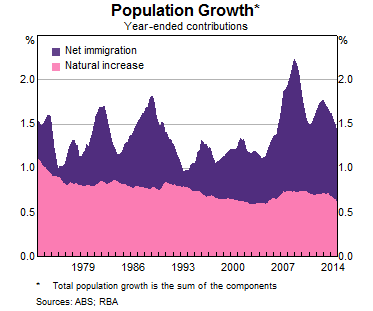In an address by Christopher Kent, RBA Assistant Governor (Economic), he looks at changes in the labour market and concludes that as population growth is slower than expected, effective employment utilisation is higher. Significantly, also, more Australians are now employed in the service sector.
The change in population growth rates is significant, and relevant to future demand for housing, and GDP estimates.
Official data suggested that the working-age population had been growing by about 1.7 per cent per annum, and it was expected to continue at about that rate in the foreseeable future. However, the most recent data from the ABS suggest that total population growth had dropped quite noticeably over the past year or so, from 1.8 per cent over 2012 to 1.4 per cent over 2014. Estimates of the working-age population are expected to be revised down accordingly in coming months.
The decline in population growth was mainly the result of a decline in net immigration. This appears to be related to the weakening in Australia’s labour market conditions relative to those of other countries. Of course, people on temporary skilled-work visas (so-called ‘457s’) leave for home when their jobs end. But there has also been a large decline in net immigration from New Zealand. Labour market conditions in New Zealand tightened at the same time that spare capacity in the Australian labour market increased. The reconstruction activity in Christchurch took off around the time that construction in Australia’s resource sector was winding down. Indeed, the key mining states of Queensland and Western Australia have seen the largest declines in net immigration. It also appears that Australia’s intake of international students has not picked up to the extent previously anticipated.The unexpected slowdown in population growth implies somewhat less rapid growth of our labour force than otherwise. This means that the GDP growth that we have recorded may have been closer to the recent growth in the economy’s productive capacity than previously thought. If so, that would have left the economy with a little less spare capacity (a lower unemployment rate) than had been expected.

